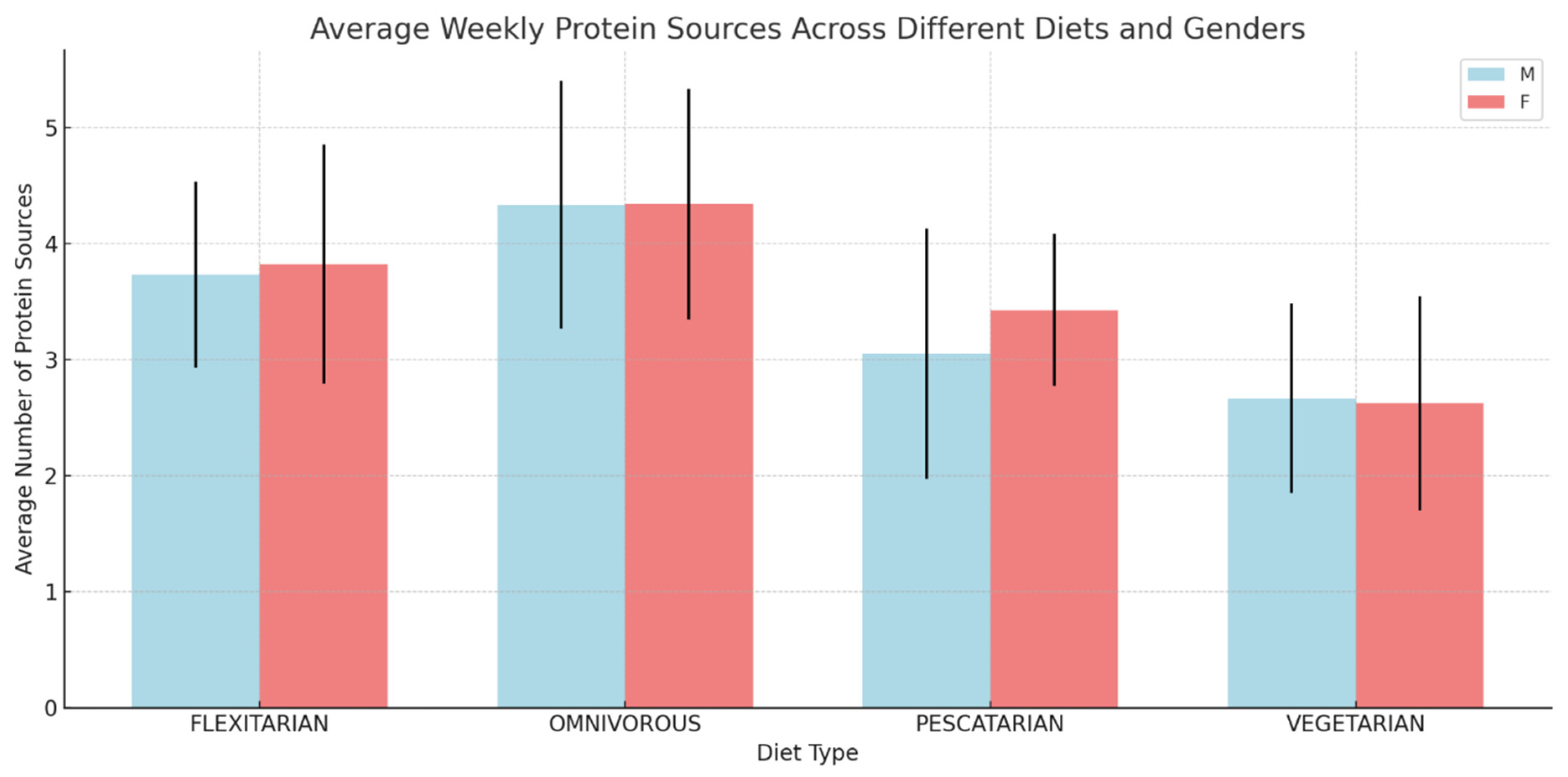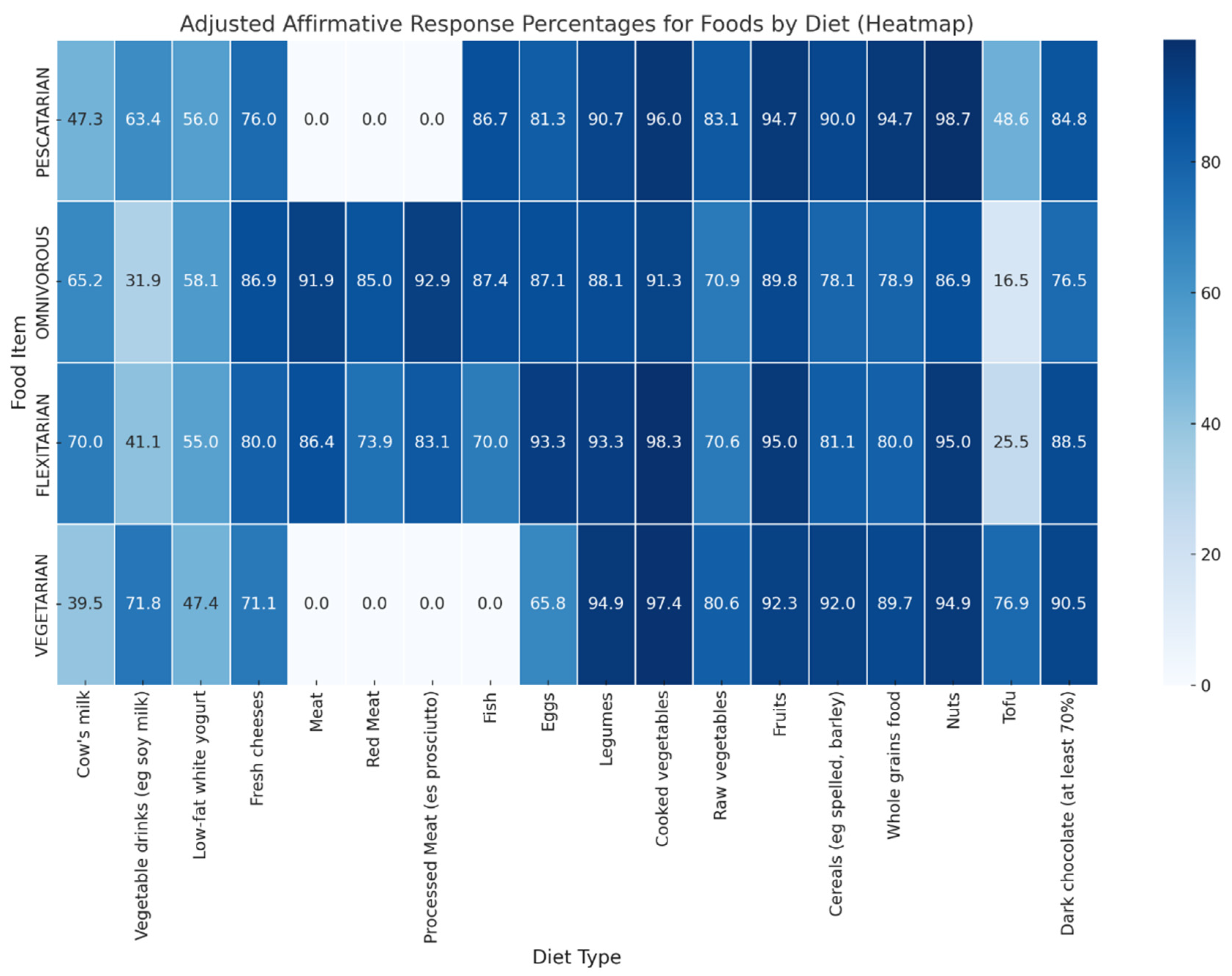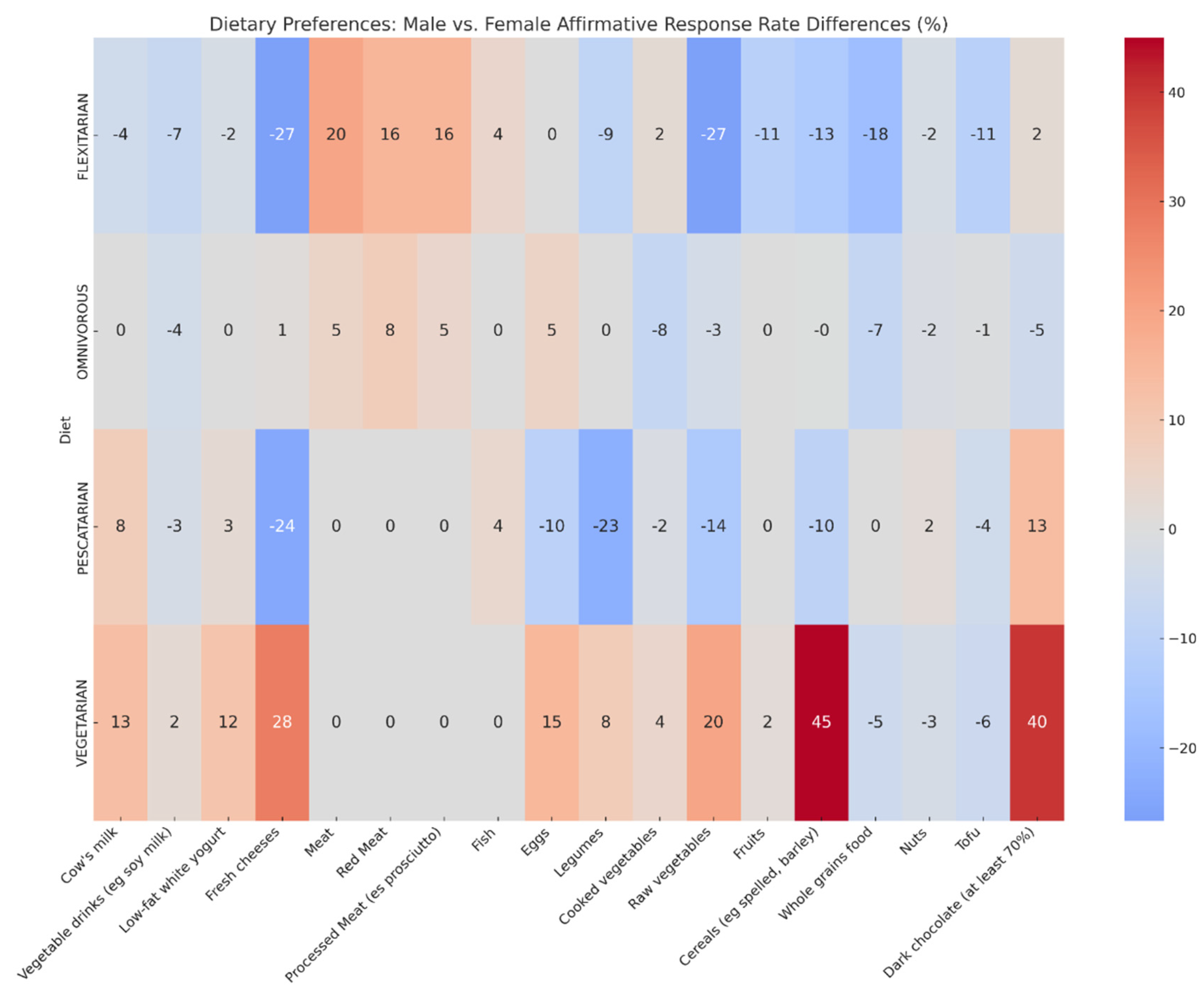Effects of Different Nutritional Patterns and Physical Activity on Body Composition: A Gender and Age Group Comparative Study
Abstract
1. Introduction
2. Methods
2.1. Subjects
2.2. Dietary Patterns
2.3. Questionnaire
2.4. Body Composition
2.5. Statistical Analysis
3. Results
4. Discussion
5. Conclusions
Supplementary Materials
Author Contributions
Funding
Institutional Review Board Statement
Informed Consent Statement
Data Availability Statement
Acknowledgments
Conflicts of Interest
References
- Neuhouser, M.L. The importance of healthy dietary patterns in chronic disease prevention. Nutr. Res. 2019, 70, 3–6. [Google Scholar] [CrossRef]
- de Oliveira Otto, M.C.; Anderson, C.A.M.; Dearborn, J.L.; Ferranti, E.P.; Mozaffarian, D.; Rao, G.; Wylie-Rosett, J.; Lichtenstein, A.H.; American Heart Association Behavioral Change for Improving Health Factors Committee of the Council on Lifestyle and Cardiometabolic Health and Council on Epidemiology and Prevention; Council on Cardiovascular and Stroke Nursing; et al. Dietary Diversity: Implications for Obesity Prevention in Adult Populations: A Science Advisory from the American Heart Association. Circulation 2018, 138, e160–e168, Erratum in Circulation 2018, 138, e712. [Google Scholar] [CrossRef] [PubMed]
- Qu, X.; Na, X.; Yang, J.; Yu, H.; Chen, A.; Zhao, A. Reaching and maintaining higher dietary diversity is associated with decreased risk of all-cause mortality: A longitudinal study from the China Health and Nutrition Survey. Front. Nutr. 2022, 9, 947290. [Google Scholar] [CrossRef] [PubMed]
- Satija, A.; Hu, F.B. Plant-based diets and cardiovascular health. Trends Cardiovasc. Med. 2018, 28, 437–441. [Google Scholar] [CrossRef] [PubMed]
- Thompson, A.S.; Tresserra-Rimbau, A.; Karavasiloglou, N.; Jennings, A.; Cantwell, M.; Hill, C.; Perez-Cornago, A.; Bondonno, N.P.; Murphy, N.; Rohrmann, S.; et al. Association of Healthful Plant-based Diet Adherence with Risk of Mortality and Major Chronic Diseases Among Adults in the UK. JAMA Netw. Open 2023, 6, e234714. [Google Scholar] [CrossRef]
- Koch, C.A.; Kjeldsen, E.W.; Frikke-Schmidt, R. Vegetarian or vegan diets and blood lipids: A meta-analysis of randomized trials. Eur. Heart J. 2023, 44, 2609–2622. [Google Scholar] [CrossRef]
- Agnoli, C.; Baroni, L.; Bertini, I.; Ciappellano, S.; Fabbri, A.; Goggi, S.; Metro, D.; Papa, M.; Sbarbati, R.; Scarino, M.L.; et al. A comprehensive review of healthy effects of vegetarian diets. Nutr. Metab. Cardiovasc. Dis. 2023, 33, 1308–1315. [Google Scholar] [CrossRef]
- Lombardo, M.; Bellia, C.; Moletto, C.; Aulisa, G.; Padua, E.; Della-Morte, D.; Caprio, M.; Bellia, A. Effects of Quality and Quantity of Protein Intake for Type 2 Diabetes Mellitus Prevention and Metabolic Control. Curr. Nutr. Rep. 2020, 9, 329–337. [Google Scholar] [CrossRef]
- Wang, Y.; Liu, B.; Han, H.; Hu, Y.; Zhu, L.; Rimm, E.B.; Hu, F.B.; Sun, Q. Associations between plant-based dietary patterns and risks of type 2 diabetes, cardiovascular disease, cancer, and mortality—A systematic review and meta-analysis. Nutr. J. 2023, 22, 46. [Google Scholar] [CrossRef]
- Moreno, L.A.; Meyer, R.; Donovan, S.M.; Goulet, O.; Haines, J.; Kok, F.J.; Van’t Veer, P. Perspective: Striking a Balance between Planetary and Human Health. Is There a Path Forward? Adv. Nutr. 2022, 13, 355–375, Erratum in Adv. Nutr. 2022, 13, 2064. [Google Scholar] [CrossRef]
- Kondrup, S.V.; Holm, L.; Sandøe, P.; Lund, T.B. Various ways towards animal product limiting—Practical and social engagements in initial phase of dietary change. Appetite 2023, 186, 106571. [Google Scholar] [CrossRef] [PubMed]
- Brytek-Matera, A. Interaction between Vegetarian Versus Omnivorous Diet and Unhealthy Eating Patterns (Orthorexia Nervosa, Cognitive Restraint) and Body Mass Index in Adults. Nutrients 2020, 12, 646. [Google Scholar] [CrossRef] [PubMed]
- Kim, G.; Oh, J.; Cho, M. Differences between Vegetarians and Omnivores in Food Choice Motivation and Dietarian Identity. Foods 2022, 11, 539. [Google Scholar] [CrossRef] [PubMed]
- Verain, M.C.D.; Dagevos, H. Comparing meat abstainers with avid meat eaters and committed meat reducers. Front. Nutr. 2022, 9, 1016858. [Google Scholar] [CrossRef] [PubMed]
- Carbonneau, E.; Bradette-Laplante, M.; Lamarche, B.; Provencher, V.; Bégin, C.; Robitaille, J.; Desroches, S.; Vohl, M.C.; Corneau, L.; Lemieux, S. Development and Validation of the Food Liking Questionnaire in a French-Canadian Population. Nutrients 2017, 9, 1337. [Google Scholar] [CrossRef] [PubMed]
- Perrone, M.A.; Feola, A.; Pieri, M.; Donatucci, B.; Salimei, C.; Lombardo, M.; Perrone, A.; Parisi, A. The Effects of Reduced Physical Activity on the Lipid Profile in Patients with High Cardiovascular Risk during COVID-19 Lockdown. Int. J. Environ. Res. Public Health 2021, 18, 8858. [Google Scholar] [CrossRef] [PubMed]
- Lombardo, M.; Aulisa, G.; Padua, E.; Annino, G.; Iellamo, F.; Pratesi, A.; Caprio, M. and Bellia, A. Gender differences in taste and foods habits. Nutr. Food Sci. 2020, 50, 229–239. [Google Scholar] [CrossRef]
- Vasold, K.L.; Parks, A.C.; Phelan, D.M.L.; Pontifex, M.B.; Pivarnik, J.M. Reliability and Validity of Commercially Available Low-Cost Bioelectrical Impedance Analysis. Int. J. Sport. Nutr. Exerc. Metab. 2019, 29, 406–410. [Google Scholar] [CrossRef]
- Johannsen, D.L.; Calabro, M.A.; Stewart, J.; Franke, W.; Rood, J.C.; Welk, G.J. Accuracy of armband monitors for measuring daily energy expenditure in healthy adults. Med. Sci. Sports Exerc. 2010, 42, 2134–2140. [Google Scholar] [CrossRef]
- Monterrosa, E.C.; Frongillo, E.A.; Drewnowski, A.; de Pee, S.; Vandevijvere, S. Sociocultural Influences on Food Choices and Implications for Sustainable Healthy Diets. Food Nutr. Bull. 2020, 41 (Suppl. 2), 59S–73S. [Google Scholar] [CrossRef]
- Jarvis, S.E.; Nguyen, M.; Vasanti, S.M. Association between adherence to plant-based dietary patterns and obesity risk: A systematic review of prospective cohort studies. Appl. Physiol. Nutr. Metab. 2022, 47, 1115–1133. [Google Scholar] [CrossRef]
- Fontes, T.; Rodrigues, L.M.; Ferreira-Pêgo, C. Comparison between Different Groups of Vegetarianism and Its Associations with Body Composition: A Literature Review from 2015 to 2021. Nutrients 2022, 14, 1853. [Google Scholar] [CrossRef]
- Jedut, P.; Glibowski, P.; Skrzypek, M. Comparison of the Health Status of Vegetarians and Omnivores Based on Biochemical Blood Tests, Body Composition Analysis and Quality of Nutrition. Nutrients 2023, 15, 3038. [Google Scholar] [CrossRef] [PubMed]
- Modlinska, K.; Adamczyk, D.; Maison, D.; Pisula, W. Gender Differences in Attitudes to Vegans/Vegetarians and Their Food Preferences, and Their Implications for Promoting Sustainable Dietary Patterns–A Systematic Review. Sustainability 2020, 12, 6292. [Google Scholar] [CrossRef]
- Stanley, S.K.; Day, C.; Brown, P.M. Masculinity Matters for Meat Consumption: An Examination of Self-Rated Gender Typicality, Meat Consumption, and Veganism in Australian Men and Women. Sex Roles 2023, 88, 187–198. [Google Scholar] [CrossRef]
- Johnston, R.; Poti, J.M.; Popkin, B.M. Eating and aging: Trends in dietary intake among older Americans from 1977–2010. J. Nutr. Health Aging 2014, 18, 234–242. [Google Scholar] [CrossRef] [PubMed]
- De Backer, C.; Erreygers, S.; De Cort, C.; Vandermoere, F.; Dhoest, A.; Vrinten, J.; Van Bauwel, S. Meat and masculinities. Can differences in masculinity predict meat consumption, intentions to reduce meat and attitudes towards vegetarians? Appetite 2020, 147, 104559. [Google Scholar] [CrossRef] [PubMed]
- Rosenfeld, D.L.; Tomiyama, A.J. Gender differences in meat consumption and openness to vegetarianism. Appetite 2021, 166, 105475. [Google Scholar] [CrossRef] [PubMed]
- Kubberød, E.; Ueland, Ø.; Rødbotten, M.; Westad, F.; Risvik, E. Gender specific preferences and attitudes towards meat. Food Qual. Prefer. 2002, 13, 285–294. [Google Scholar] [CrossRef]
- Ford, H.; Gould, J.; Danner, L.; Bastian, S.E.P.; Yang, Q. “I guess it’s quite trendy”: A qualitative insight into young meat-eaters’ sustainable food consumption habits and perceptions towards current and future protein alternatives. Appetite 2023, 190, 107025. [Google Scholar] [CrossRef]
- Singh, N.; Jain, P.; Ujinwal, M.; Langyan, S. Escalate protein plates from legumes for sustainable human nutrition. Front. Nutr. 2022, 9, 977986. [Google Scholar] [CrossRef]
- Alcorta, A.; Porta, A.; Tárrega, A.; Alvarez, M.D.; Vaquero, M.P. Foods for Plant-Based Diets: Challenges and Innovations. Foods 2021, 10, 293. [Google Scholar] [CrossRef]
- Brandner, M.M.E.; Fyfe, C.L.; Horgan, G.W.; Johnstone, A.M. Self-Reported Purchasing Behaviour, Sociodemographic Predictors of Plant-Based Protein Purchasing and Knowledge about Protein in Scotland and England. Nutrients 2022, 14, 4706. [Google Scholar] [CrossRef]
- Alae-Carew, C.; Green, R.; Stewart, C.; Cook, B.; Dangour, A.D.; Scheelbeek, P.F.D. The role of plant-based alternative foods in sustainable and healthy food systems: Consumption trends in the UK. Sci. Total Environ. 2022, 807, 151041. [Google Scholar] [CrossRef]
- Bakaloudi, D.R.; Halloran, A.; Rippin, H.L.; Oikonomidou, A.C.; Dardavesis, T.I.; Williams, J.; Wickramasinghe, K.; Breda, J.; Chourdakis, M. Intake and adequacy of the vegan diet. A systematic review of the evidence. Clin. Nutr. 2021, 40, 3503–3521. [Google Scholar] [CrossRef] [PubMed]
- Orlich, M.J.; Fraser, G.E. Vegetarian diets in the Adventist Health Study 2: A review of initial published findings. Am. J. Clin. Nutr. 2014, 100, 353S–358S. [Google Scholar] [CrossRef] [PubMed]
- Huang, R.Y.; Huang, C.C.; Hu, F.B.; Chavarro, J.E. Vegetarian Diets and Weight Reduction: A Meta-Analysis of Randomized Controlled Trials. J. Gen. Intern. Med. 2016, 31, 109–116. [Google Scholar] [CrossRef] [PubMed]
- Lombardo, M.; Boaria, A.; Aulisa, G.; Padua, E.; Annino, G.; Pratesi, A.; Caprio, M.; Iellamo, F.; Bellia, A. Sarcopenic obesity: Etiology and lifestyle therapy. Eur. Rev. Med. Pharmacol. Sci. 2019, 23, 7152–7162. [Google Scholar] [CrossRef]
- Derbyshire, E.J. Flexitarian Diets and Health: A Review of the Evidence-Based Literature. Front. Nutr. 2017, 3, 55. [Google Scholar] [CrossRef] [PubMed]
- Lynch, H.; Johnston, C.; Wharton, C. Plant-Based Diets: Considerations for Environmental Impact, Protein Quality, and Exercise Performance. Nutrients 2018, 10, 1841. [Google Scholar] [CrossRef] [PubMed]
- Kwiatkowska, I.; Olszak, J.; Formanowicz, P.; Formanowicz, D. Nutritional Status and Habits among People on Vegan, Lacto/Ovo-Vegetarian, Pescatarian and Traditional Diets. Nutrients 2022, 14, 4591. [Google Scholar] [CrossRef] [PubMed]
- Monteyne, A.J.; Coelho, M.O.C.; Murton, A.J.; Abdelrahman, D.R.; Blackwell, J.R.; Koscien, C.P.; Knapp, K.M.; Fulford, J.; Finnigan, T.J.A.; Dirks, M.L.; et al. Vegan and Omnivorous High Protein Diets Support Comparable Daily Myofibrillar Protein Synthesis Rates and Skeletal Muscle Hypertrophy in Young Adults. J. Nutr. 2023, 153, 1680–1695. [Google Scholar] [CrossRef] [PubMed]
- Hevia-Larraín, V.; Gualano, B.; Longobardi, I.; Gil, S.; Fernandes, A.L.; Costa, L.A.R.; Pereira, R.M.R.; Artioli, G.G.; Phillips, S.M.; Roschel, H. High-Protein Plant-Based Diet Versus a Protein-Matched Omnivorous Diet to Support Resistance Training Adaptations: A Comparison Between Habitual Vegans and Omnivores. Sports Med. 2021, 51, 1317–1330. [Google Scholar] [CrossRef] [PubMed]




| Total (n) | M | F | p-Value | ||
|---|---|---|---|---|---|
| Total | n | 1342 | 553 (41.2%) | 789 (58.8%) | <0.0001 |
| Age | yrs | 39.4 ± 11.8 | 38.2 ± 11.6 | 40.2 ± 11.8 | <0.0001 |
| 18–30 | n (%) | 326 (24.3%) | 146 (44.8%) | 180 (55.2%) | 0.007 |
| 31–45 | 566 (42.2%) | 248 (43.8%) | 318 (56.2%) | ||
| 46–65 | 450 (33.6%) | 159 (35.3%) | 291 (64.7%) | ||
| Weight | kg | 79.9 ± 17.6 | 89.5 ± 17.2 | 73.3 ± 14.6 | <0.0001 |
| BMI | kg/m2 | 28.1 ± 5.2 | 28.8 ± 5.1 | 27.6 ± 5.2 | <0.0001 |
| <18.5 | n (%) | 9 (0.7%) | 2 (22.2%) | 7 (77.8%) | 0.005 |
| 18.5–24.9 | 391 (31.2%) | 131 (33.5%) | 260 (66.5%) | ||
| 25.0–29.9 | 531 (42.3%) | 225 (42.4%) | 306 (57.6%) | ||
| 30.0–34.9 | 275 (21.9%) | 133 (48.4%) | 142 (51.6%) | ||
| 35.0–39.9 | 104 (8.3%) | 48 (46.2%) | 56 (53.8%) | ||
| 40.0–44.9 | 24 (1.9%) | 10 (41.7%) | 14 (58.3%) | ||
| ≥45 | 8 (0.6%) | 4 (50.0%) | 4 (50.0%) | ||
| FM | kg | 25.0 ± 10.7 | 23.2 ± 10.9 | 26.2 ± 10.4 | <0.0001 |
| FM | % | 30.6 ± 9.0 | 24.8 ± 7.6 | 34.6 ± 7.5 | <0.0001 |
| AC | cm | 96.8 ± 14 | 101.1 ± 14.1 | 93.8 ± 13.1 | <0.0001 |
| FFM | kg | 52.2 ± 11.2 | 62.9 ± 8.1 | 44.6 ± 5.3 | <0.0001 |
| Body Water | lt | 38.8 ± 8.4 | 46.7 ± 6.1 | 33.2 ± 4.4 | <0.0001 |
| BMR | Kcal | 1656.1 ± 342.1 | 1963.5 ± 272.6 | 1439.8 ± 183.9 | <0.0001 |
| BMI | ||||||||
|---|---|---|---|---|---|---|---|---|
| Diet | (n) | <18.5 | 18.5–24.9 | 25.0–29.9 | 30.0–34.9 | 35.0–39.9 | 40.0–44.9 | ≥45 |
| Flexitarian | F (42) | 0 (0.0%) | 18 (42.9%) | 13 (31.0%) | 5 (11.9%) | 5 (11.9%) | 1 (2.4%) | 0 (0.0%) |
| M (13) | 0 (0.0%) | 6 (46.2%) | 4 (30.8%) | 3 (23.1%) | 0 (0.0%) | 0 (0.0%) | 0 (0.0%) | |
| Total (55) | 0 (20.0%) | 24 (43.6%) | 17 (30.9%) | 8 (14.5%) | 5 (9.1%) | 1 (1.8%) | 0 (0.0%) | |
| Omnivorous | F (670) | 5 (0.7%) | 210 (31.3%) | 263 (39.3%) | 125 (18.7%) | 50 (7.5%) | 13 (1.9%) | 4 (0.6%) |
| M (507) | 2 (0.4%) | 112 (22.1%) | 207 (40.8%) | 126 (24.9%) | 47 (9.3%) | 9 (1.8%) | 4 (0.8%) | |
| Total (1177) | 7 (0.6%) | 322 (27.4%) | 470 (39.9%) | 251 (21.3%) | 97 (8.2%) | 22 (1.9%) | 8 (0.7%) | |
| Pescatarian | F (53) | 0 (0.0%) | 27 (50.9%) | 17 (32.1%) | 9 (17.0%) | 0 (0.0%) | 0 (0.0%) | 0 (0.0%) |
| M (19) | 0 (0.0%) | 10 (52.6%) | 8 (42.1%) | 0 (0.0%) | 1 (5.3%) | 0 (0.0%) | 0 (0.0%) | |
| Total (72) | 0 (25.0%) | 37 (51.4%) | 25 (34.7%) | 9 (12.5%) | 1 (1.4%) | 0 (25.0%) | 0 (0.0%) | |
| Vegetarian | F (24) | 2 (8.3%) | 5 (20.8%) | 13 (54.2%) | 3 (12.5%) | 1 (4.2%) | 0 (0.0%) | 0 (0.0%) |
| M (14) | 0 (0.0%) | 3 (21.4%) | 6 (42.9%) | 4 (28.6%) | 0 (0.0%) | 1 (7.1%) | 0 (0.0%) | |
| Total (38) | 2 (5.3%) | 8 (21.1%) | 19 (16.7%) | 7 (18.4%) | 1 (2.6%) | 1 (2.6%) | 0 (0.0%) | |
| Total | M | F | ||||||||||
|---|---|---|---|---|---|---|---|---|---|---|---|---|
| Age Group | 18–30 | 31–45 | 46–65 | p-Value | 18–30 | 31–45 | 46–65 | p-Value | 18–30 | 31–45 | 46–65 | p-Value |
| Meat | 28.8% | 24.6% | 22.6% | 0.094 | 42.8% a | 30.4% a | 24.1% b | 0.004 | 17.4% a | 20.0% a | 21.8% b | 0.616 |
| Processed Meat | 18% | 17.8% | 18.3% | 0.925 | 26.2% a | 25.5% a | 24.7% a | 0.808 | 11.2% a | 11.8% a | 14.9% a | 0.143 |
| Fish | 21.7% | 20.3% | 19.9% | 0.823 | 29% a | 25.9% a | 30.4% a | 0.817 | 15.7% a | 15.9% a | 14.2% a | 0.431 |
| Eggs | 14.9% | 10.1% | 8.5% | 0.112 | 21.4% a | 12.2% b | 14.6% a | 0.45 | 9.6% a | 8.6% b | 5.2% a | 0.098 |
| Dairy | 14.2% | 15.3% | 17.9% | 0.184 | 20% a | 17.4% b | 20.3% b | 0.28 | 9.6% a | 13.7% b | 16.6% b | 0.417 |
| Legumes | 23.8% | 21.9% | 21.9% | 0.787 | 22.1% b | 25.1% b | 23.4% b | 0.641 | 25.3% b | 19.4% b | 21.1% b | 0.556 |
| Soy | 12.1% | 12.8% | 5.4% | 0.002 | 8.3% b | 10.9% b | 3.2% b | 0.019 | 15.2% b | 14.3% b | 6.6% b | 0.024 |
| n. protein sources | 11.2% | 11.9% | 8.8% | 0.213 | 11.5% b | 17.8% b | 14% a | 0.876 | 11% b | 19.4% b | 7.5% a | 0.673 |
Disclaimer/Publisher’s Note: The statements, opinions and data contained in all publications are solely those of the individual author(s) and contributor(s) and not of MDPI and/or the editor(s). MDPI and/or the editor(s) disclaim responsibility for any injury to people or property resulting from any ideas, methods, instructions or products referred to in the content. |
© 2024 by the authors. Licensee MDPI, Basel, Switzerland. This article is an open access article distributed under the terms and conditions of the Creative Commons Attribution (CC BY) license (https://creativecommons.org/licenses/by/4.0/).
Share and Cite
Lombardo, M.; Feraco, A.; Camajani, E.; Gorini, S.; Strollo, R.; Armani, A.; Padua, E.; Caprio, M. Effects of Different Nutritional Patterns and Physical Activity on Body Composition: A Gender and Age Group Comparative Study. Foods 2024, 13, 529. https://doi.org/10.3390/foods13040529
Lombardo M, Feraco A, Camajani E, Gorini S, Strollo R, Armani A, Padua E, Caprio M. Effects of Different Nutritional Patterns and Physical Activity on Body Composition: A Gender and Age Group Comparative Study. Foods. 2024; 13(4):529. https://doi.org/10.3390/foods13040529
Chicago/Turabian StyleLombardo, Mauro, Alessandra Feraco, Elisabetta Camajani, Stefania Gorini, Rocky Strollo, Andrea Armani, Elvira Padua, and Massimiliano Caprio. 2024. "Effects of Different Nutritional Patterns and Physical Activity on Body Composition: A Gender and Age Group Comparative Study" Foods 13, no. 4: 529. https://doi.org/10.3390/foods13040529
APA StyleLombardo, M., Feraco, A., Camajani, E., Gorini, S., Strollo, R., Armani, A., Padua, E., & Caprio, M. (2024). Effects of Different Nutritional Patterns and Physical Activity on Body Composition: A Gender and Age Group Comparative Study. Foods, 13(4), 529. https://doi.org/10.3390/foods13040529












